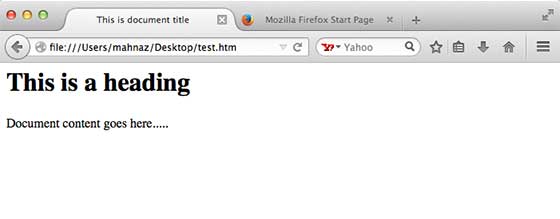HTML Tutorial
HTML stands for Hyper Text Markup Language, which is the most widely used language on Web to develop web pages.
HTML was created by Berners-Lee in late 1991 but "HTML 2.0" was the first standard HTML specification which was published in 1995. HTML 4.01 was a major version of HTML and it was published in late 1999. Though HTML 4.01 version is widely used but currently we are having HTML-5 version which is an extension to HTML 4.01, and this version was published in 2012.
Audience
This tutorial is designed for the aspiring Web Designers and Developers with a need to understand the HTML in enough detail along with its simple overview, and practical examples. This tutorial will give you enough ingredients to start with HTML from where you can take yourself at higher level of expertise.
Prerequisites
Before proceeding with this tutorial you should have a basic working knowledge with Windows or Linux operating system, additionally you must be familiar with:
- Experience with any text editor like notepad, notepad++, or Editplus etc.
- How to create directories and files on your computer.
- How to navigate through different directories.
- How to type content in a file and save them on a computer.
- Understanding about images in different formats like JPEG, PNG format.
Try HTML Online
For most of the examples given in this tutorial you will find Try it option available, so just make use of it to see the output of your code and enjoy your learning.
Try following example using Try it option available at the top right corner of the below sample code box:
<!DOCTYPE html> <html> <body> <h1>Hello World!</h1> </body> </html>
Introduction
HTML stands for Hypertext Markup Language, and it is the most widely used language to write Web Pages.
- Hypertext refers to the way in which Web pages (HTML documents) are linked together. Thus the link available on a webpage are called Hypertext.
- As its name suggests, HTML is a Markup Language which means you use HTML to simply "mark up" a text document with tags that tell a Web browser how to structure it to display.
Originally, HTML was developed with the intent of defining the structure of documents like headings, paragraphs, lists, and so forth to facilitate the sharing of scientific information between researchers.
Now, HTML is being widely used to format web pages with the help of different tags available in HTML language.
Basic HTML Document
In its simplest form, following is an example of an HTML document:
<!DOCTYPE html> <html> <head> <title>This is document title</title> </head> <body> <h1>This is a heading</h1> <p>Document content goes here.....</p> </body> </html>
Either you can use Try it option available at the top right corner of the code box to check the result of this HTML code, or let's save it in an HTML file test.htm using your favorite text editor. Finally open it using a web browser like Internet Explorer or Google Chrome, or Firefox etc. It must show the following output:

HTML Tags
As told earlier, HTML is a markup language and makes use of various tags to format the content. These tags are enclosed within angle braces <Tag Name>. Except few tags, most of the tags have their corresponding closing tags. For example <html> has its closing tag</html> and <body> tag has its closing tag </body> tag etc.
Above example of HTML document uses folloiwng tags:
| Tag | Description |
|---|---|
| <!DOCTYPE...> | This tag defines the document type and HTML version. |
| <html> | This tag encloses the complete HTML document and mainly comprises of document header which is represented by <head>...</head> and document body which is represented by <body>...</body> tags. |
| <head> | This tag represents the document's header which can keep other HTML tags like <title>, <link> etc. |
| <title> | The <title> tag is used inside the <head> tag to mention the document title. |
| <body> | This tag represents the document's body which keeps other HTML tags like <h1>, <div>, <p> etc. |
| <h1> | This tag represents the heading. |
| <p> | This tag represents a paragraph. |
To learn HTML, you will need to study various tags and understand how do they behave while formatting a textual document. Learning HTML is simple as users have to learn the usage of different tags in order to format the text or images to make a beautiful webpage.
World Wide Web Consortium (W3C) recommends to use lowercase tags starting from HTML 4.
HTML Document Structure
A typical HTML document will have following structure:
Document declaration tag
<html>
<head>
Document header related tags
</head>
<body>
Document body related tags
</body>
</html>
We will study all the header and body tags in subsequent chapters, for now let's see what is document declaration tag.
The <!DOCTYPE> Declaration
The <!DOCTYPE> declaration tag is used by the web browser to understand the version of the HTML used in the document. Current version of HTML is 5 and it makes use of the following declaration:
<!DOCTYPE html>
There are many other declaration types which can be used in HTML document depending on what version of HTML is being used. We will see more details on this while discussing <!DOCTYPE...> tag along with other HTML tags.


ConversionConversion EmoticonEmoticon